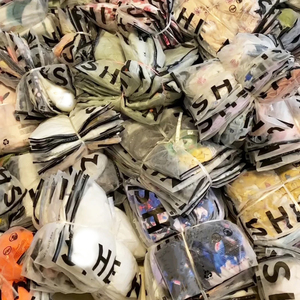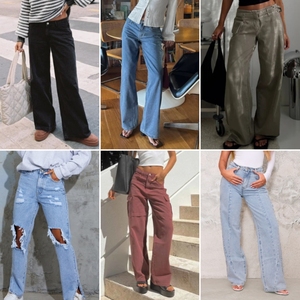(1000 products available)



































































































































































































































Overstock lots are products that remain unsold after a season or for another reason. There are many types of overstock lots depending on the reasons for overstocking and the products involved. Here are some important types:
Apparel Overstock Lots
Apparel overstock lots contain clothing items that are overstocked. They may contain different shirt or dress sizes, styles, colors, or accessories. Buyers may purchase them at a discount to resell or use them for other purposes. Overstock can occur due to higher production than demand, seasonal trends, or store closings. Overstock apparel lots are a great way for businesses to acquire new products.
Shoe Overstock Lots
Shoe overstock lots contain unsold footwear. They may have various sizes, styles, and colors. Buyers purchase them at a discount to resell or use. Overstock happens due to overproduction, changing trends, or store closings. Overstock shoe lots offer businesses a way to acquire new products.
Accessory Overstock Lots
Accessory overstock lots contain extra unsold items. They may include bags, belts, jewelry, and scarves. Lots can vary in size and value. They may come from store closings or overproduction. Buyers purchase them at a discount to resell or use. Accessory overstock offers businesses a way to find products.
General Merchandise Overstock
General merchandise overstock lots contain various unsold items. They may include household goods, electronics, toys, and clothing. Lots can vary in size and value. They may come from store closings, overproduction, or changing trends. Buyers purchase them at a discount to resell or use. General merchandise overstock offers businesses a way to find products.
Liquidation Overstock Lots
Liquidation overstock lots contain unsold items from closed stores or warehouses. They may include apparel, shoes, accessories, and general merchandise. Lots can vary in size and value. They may include shelf pulls, returns, and damaged items. Buyers purchase them at a discount to resell or use. Liquidation overstock offers businesses a way to find products.
Seasonal Overstock Lots
Seasonal overstock lots contain unsold items from a specific season. They may include holiday decor, summer apparel, and winter goods. Lots can vary in size and value. They may come from changing trends or overproduction. Buyers purchase them at a discount to resell or use. Seasonal overstock offers businesses a way to find products.
High-End Overstock Lots
Overstock lots may also be high-end. They contain unsold luxury items from closed stores or warehouses. They may include designer apparel, shoes, accessories, and general merchandise. Lots can vary in size and value and include returns or damaged items. Buyers purchase them at a discount to resell or use. High-end overstock offers businesses a way to find products Apparel overstock lots may contain clothing items that are overstocked.
Miscellaneous Overstock Lots
Miscellaneous overstock lots contain various unsold items. They may include apparel, shoes, accessories, household goods, electronics, toys, and clothing. They may come from store closings, overproduction, or changing trends. Buyers purchase them at a discount to resell or use.
Overstock lots are merchandise that retailers, wholesalers, or manufacturers have in excess of what they need. These lots can include various items, such as apparel, electronics, furniture, and more. The design of overstock lots involves categorizing and presenting these excess items in a way that maximizes their appeal to potential buyers, often at discounted prices. Here are some key design elements to consider:
Lot Categorization
Categorizing overstock lots is the first design step. Items are grouped based on factors like product type, brand, condition, and target market. This helps buyers find what they want and makes browsing easier. Categories might include apparel, electronics, home goods, and more. Each group is organized for quick access and visual appeal.
Inventory Management
Effective inventory management is key to handling overstock lots. It tracks stock levels in real time to avoid shortages or surpluses. It uses barcodes or RFID tags for quick item checks. Software systems update data automatically and provide reports. This helps make informed decisions about sales and restocks. It ensures a smooth flow of goods in and out of the storage. Proper management saves time and costs and keeps customers satisfied.
Visual Presentation
Visual presentation is crucial for overstock lots. It uses attractive layouts to showcase products. Good lighting highlights key features. Informative signs guide customers. Clean, organized spaces make items easy to find. Online, high-quality images and clear descriptions sell products. Consistent branding builds trust. These strategies draw customers and boost sales.
Condition Disclosure
Condition disclosure is vital in overstock lot design. It informs buyers about each item's state. Clear labels show if products are new, used, or damaged. New items may have minor packaging flaws. Open-box products are like new but have been unpacked. Customer returns might be unused but returned for various reasons. Accurate descriptions build trust and help buyers make informed choices. This transparency leads to smoother sales and happier customers.
Lot Packaging
Designing packaging for overstock lots requires a balance of functionality and appeal. Each package must securely hold varied items, from electronics to apparel, protecting them during transport and storage. Clear labeling is essential for inventory management and buyer identification. It should include lot numbers, item descriptions, and handling instructions. Consider using eco-friendly materials to enhance sustainability. The design should facilitate easy access and repackaging, accommodating different item sizes and shapes efficiently.
Marketing and Sales Strategy
Lot marketing involves presenting excess inventory attractively to buyers. It highlights key products and discounts. Clear signage and online listings draw attention. Social media campaigns create buzz. Email alerts inform loyal customers of new lots. The goal is to sell overstock quickly while maintaining brand image. Effective lot marketing turns surplus stock into opportunity.
Customer Experience
Enhancing customer experience in overstock lots involves creating an organized, inviting space where shoppers can easily navigate through discounted products. Clear signage, well-defined categories, and knowledgeable staff contribute to a positive atmosphere. Interactive elements such as product demos and loyalty programs can further engage customers. Additionally, maintaining a clean, safe environment and offering flexible payment and return options help build trust and satisfaction, encouraging repeat visits and long-term relationships with buyers.
Overstock lots can be formally worn and matched in various ways. For instance, apparel overstock can be worn by pairing a blazer with tailored trousers or pencil skirts for a polished office look or sophisticated evening attire. For casual Fridays or weekend gatherings, match a graphic tee with denim jeans and a cardigan for a laid-back yet stylish ensemble. Overstock accessories can elevate any outfit. For instance, pairing statement earrings with a simple cocktail dress or a bold necklace with a plain blouse can instantly transform a look. Footwear overstock can be matched by pairing sleek ankle boots with tailored pants for a chic urban vibe or classic pumps with a sheath dress for a timeless appeal.
Overstock lots can also be styled to reflect personal taste and the latest fashion trends. Layering is a powerful technique; for example, combining a long cardigan with a printed maxi dress and ankle boots creates a bohemian-inspired look that's perfect for weekend brunch or a casual evening out. Mixing textures is another way to add depth to an outfit; for instance, pairing a silk blouse with a leather skirt and suede heels creates a visually interesting and dynamic ensemble. Accessories can also be used to express individuality; for instance, a colorful scarf or a unique handbag can add a pop of personality to any outfit. Additionally, experimenting with different silhouettes, such as pairing a fitted top with wide-leg trousers or a flowy blouse with structured jeans, can create a balanced and visually appealing look.
For overstock apparel, it's essential to consider the current fashion trends and how they can be incorporated into everyday outfits. For example, oversized blazers are currently in vogue, and pairing one with high-waisted jeans and a cropped top can create a modern, edgy look. Similarly, the monochrome trend can be achieved by matching a navy blue turtleneck with navy blue trousers and navy blue loafers for a sleek, streamlined appearance. Color blocking is another trend that can be fun to experiment with; for instance, pairing a bright yellow top with a purple skirt and neutral shoes can create a bold and vibrant ensemble.
Q1: What are some risks associated with buying overstock lots?
A1: Buyers may sometimes receive defective items in excess or products that do not conform to the agreed specifications. There is also a risk of limited resale opportunities for certain items and the possibility of overstocking. Buyers should ask for samples before purchase and consider the lot’s resale potential.
Q2: How can one determine the value of an overstock lot?
A2: Assess the value of individual items by checking retail prices and estimating demand in the resale market. Check how much similar lots are selling for and consider the condition of the items.
Q3: Are there any legal considerations when purchasing overstock lots?
A3: Ensure the items are not stolen and that there are no outstanding liens on them. Check if there are any licenses or permits needed to buy and resell some of the items.
Q4: What should one look for in a supplier of overstock lots?
A4: Find a reliable supplier with a good reputation and track record. Check if they have a steady supply of items that one can easily resell. Look for suppliers who can give good prices and terms.
Q5: How can one resell items from an overstock lot?
A5: Sell the items online through marketplaces like eBay or Amazon. Consider selling to local retailers or wholesalers. Set up one’s own online store or sell directly to consumers through social media.